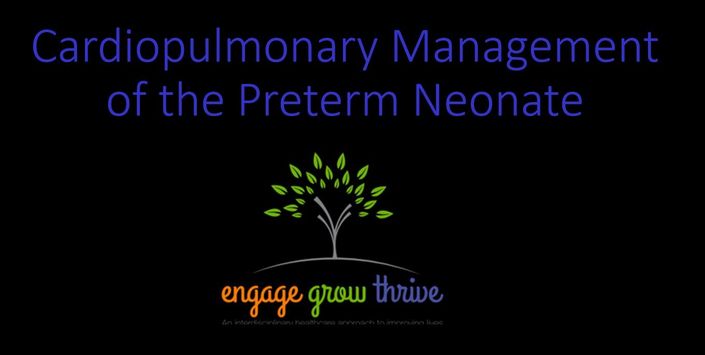
Cardiopulmonary Management of the Preterm Neonate
The cardiopulmonary transition that must occur from fetal to neonatal life is amazing and fraught with complexities in the preterm neonate who has not fully structurally and functionally matured. In this cardiopulmonary management bundle, the presentations include:
- Prevention of Bronchopulmonary Dysplasia: BPD or Chronic Lung Disease is one of the most common morbidities experienced by the preterm neonate and it can have devastating consequences. This complex morbidity remains elusive to widespread reduction across NICUs. QI efforts have proven successful in BPD reduction and there are several randomized control trials and meta-analysis to direct our practices.
- Mechanical Ventilatory Modalities: Various modes of ventilation have been utilized in the preterm neonatal population for decades. Although the mechanism of action may differ, the primary goals are similar: provide effective gas exchange and minimize lung injury. The various modes of invasive ventilation will be presented with evidence and clinical application strategies for each.
- Respiratory Strategies to Prevent Retinopathy of Prematurity: ROP is multi factorial in pathogenesis and has significant long term impact. One significant risk factor for the development of ROP is the administration of oxygen. Key processes in oxygen management and strategies to reduce severe ROP are presented.
- Apnea of Prematurity: Apnea of Prematurity (AOP) is one of the most common diagnoses for the preterm neonate in the NICU. This presentation includes definitions, pathogenesis, and evidence-based treatment strategies for the treatment of AOP.
- Patent Ductus Arteriosus: A Patent Ductus Arteriosus (PDA) is a very common challenge in the management of a preterm neonate. The recommendations for treatment include a range from monitoring and watchful waiting to medical or surgical therapies. There is no clear-cut path for management of the PDA for every neonate, although a consistent NICU approach is encouraged. This presentation will discuss the clinical signs and symptoms of a PDA and review the current state of the evidence for therapies including a discussion on catheter closure.
Objectives:
1. Identify three contributors to the cause of BPD in the premature infant.
2.Name two evidence-based or best practice strategies to prevent BPD.
3. Describe one impact of oxygen saturation targeting on the reduction of severe ROP.
4. Discuss two ways to improve compliance with oxygen targeting in the NICU.
5. Compare and Contrast the different modes of invasive conventional mechanical ventilation for infants.
6. Discuss the differences between conventional and high frequency ventilation.
7. Describe in which disease process high frequency ventilation could potentially be of most benefit.
8. Define Apnea of Prematurity.
9. Identify two strategies to treat Apnea of Prematurity.
10. Discuss signs and symptoms of PDA, their potential significance and physiologic closure in the premature infant.
11. Compare and contrast medical and surgical PDA interventions and their associated risks.
Total CE: 5.7
NCC Code NNP 2 or 7
NCC Code NIC 1, 2 or 7
NCC Code LRN 3 or 7
Rx = 1
*These presentations were included in the Small Baby Care Specialist® Program
Last updated: December 2021
Your Instructor

The presenters for the Cardiopulmonary Management Bundle include four physicians and a neonatal nurse practitioner.